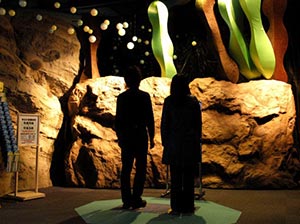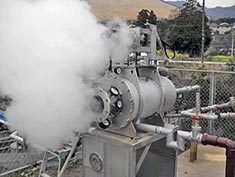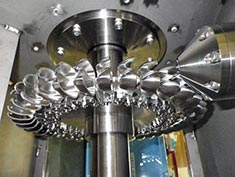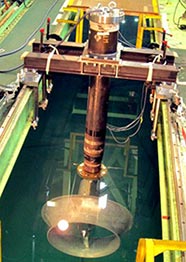Web Japan > Trends in Japan > Tech & Life > Even Steam is “Mottainai”
Even Steam is “Mottainai”
Developments in Energy Harvesting Technology

Steam rising everywhere in the hot spring town of Beppu, Oita Prefecture
Renewable energy that can be used repeatedly without depletion of resources has gained attention worldwide. Developments in innovative power generation systems that use natural energy such as solar, wind and geothermal power are in progress in Japan, alongside technological developments in energy harvesting (environmental generation) that convert the faint energies from heat and vibration occurring in daily life into electricity. The various initiatives that effectively collect the small energies around us are also a sign of the ecological spirit of mottainai in which Japan takes pride.
Generated from Unused Heat of Hot Springs
As one of the prominent volcanic countries in the world, Japan is the world's third largest geothermal resource-rich country behind the United States and Indonesia. If you travel to the hot springs, the landscape filled with rising steam conveys the blessings of nature. "Can this steam be used for generating power?" A device created from this new idea of using the excess heat—which has been released into the air without doing any good—to turn turbines was manufactured in one of Japan's leading hot spring areas of Beppu in the Oita Prefecture, and will soon be put to use.
Left: Experimental unit of yukemuri steam power generator that generates power by rotating a turbine with hot water and steam from the hot springs
© TurboBlade
Right: Turbine designed to rotate at a high speed by receiving hot water. On the right side is the nozzle for injecting hot water like a jet.
The new system is called yukemuri hatsuden (steam power generation) system. In order to draw out the maximum power from the low heat at 120°C or below not suitable for conventional geothermal power generation, this system is the first in the world to incorporate a jet of hot water to turn the turbine, in addition to the traditionally existent steam turbines. The turbine rotates at a high speed through a mechanism of receiving the power of the hot water injected like a jet from the tip of a nozzle. The hot water turbine and steam turbine have together succeeded in sending power to the generator at 3000 revolutions per minute. The output of one machine is at a maximum of 100 kilowatts, producing enough power to supply about 300 homes.
The benefit of this system is the efficient use of the hot spring source that the hot spring inns already have on hand. In addition to stably securing power without being affected by the weather as is the case for solar and wind power, the compactness that only takes up the space of one car is also very attractive. Furthermore, after turning the turbine, the hot water can be utilized as a household hot spring or as heating in winter by passing a pipe through the region, so application methods of incorporating into town development plans are also possibilities.
Hydropower Not Requiring an Elevation Drop
Left: ΣFlow™ System with an ultra-small water turbine that can generate power just by sinking into a water channel
© TOSHIBA
These natural energies are often latent within trifling landscapes. Small streams, agricultural water, and even the flow of roadside waterways are a source of energy with great potential. The ultra-small hydro power generator unit developed by a major electronics manufacturer in Japan differs from the traditional hydroelectric power plants that utilize the potential energy of water falling from above, but is a new type of generator system that can generate power from only the small flow of water. The largest selling point is that there is no need for large-scale construction work to create dams or driving channels but can be set up just with simple construction.
The newly designed flow guide and impeller are responsible for the technological foundation that uses the flow of gentle water without waste for power generation. The diameter of the flow guide entrance is larger than the diameter of the impeller, and draws an optimum curve to maximize the acceleration of the water in the vicinity of the impeller. The impeller adopts a shape similar to the blade of a propeller plane and converts the accelerated flow of water into high-speed rotation without waste. A faint flow of water automatically activates this, and a flow of 3 meters per second outputs a power supply of 2 kilowatts. It is expected not only to be used for self-consumption but also to serve a wide range of purpose such as electric power sales.
Converting Vibrations to Light

The monument at Enoshima Aquarium beautifully illuminated by LED lights lit up from the power generation floor® system utilizing step vibrations © soundpower corporation
If you visit the Enoshima Aquarium in Fujisawa City, Kanagawa Prefecture, you can experience the illumination of LED lights from the vibration energy created when a visitor steps on the floor. This device, named "power generation floor" produces 2 milliwatts of power per second from a person weighing 60kg taking just 2 steps per second. In terms of LEDs, this mechanism enables the instantaneous lighting of 100-200 bulbs. This has become a representative example of eco-power generation since fuel is not needed, air is not soiled, and it effectively uses vibrations that formerly did not serve any purpose. Mass production has begun for department stores and offices, and even for general households.
Built into the floor is a special piezoelectric device, which generates electricity when distorted by outside pressure. Although the power is small, it is capable of driving electronic devices without batteries or cables, so it can light up LED lights to locate hallways, bathrooms and rooms even if a power failure occurs during a disaster. If a sensor is employed in solitary homes of the elderly, it is even possible to automatically inform family living far away of their daily life and safety.

The power generation floor® system lighting up as a guide to the office entrance
© soundpower corporation
In addition, the power generation cane and power generation shoes that are under development by applying this technology will help to ensure the safety of those walking or running at night. The remote control switch that generates power simply by a push of a button can light up lighting equipment by sending a radio signal, and its commercialization is being highly anticipated as a new system that can shorten the time spent on indoor wiring construction when building houses and buildings.
The various power generation systems developed in Japan are likely to play a major role in the transformation of people's lifestyles.
(August 2013)




